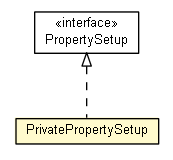
|
||||||||||
| PREV CLASS NEXT CLASS | FRAMES NO FRAMES | |||||||||
| SUMMARY: NESTED | FIELD | CONSTR | METHOD | DETAIL: FIELD | CONSTR | METHOD | |||||||||

java.lang.Objectorg.universAAL.middleware.rdf.Property.PrivatePropertySetup
protected class Property.PrivatePropertySetup
Implementation of the setup interface. For security reasons, this is
realized as a protected nested class so that only the creator of an
Ontology has access to it and can make changes.
| Field Summary | |
|---|---|
protected Property |
prop
The property. |
| Constructor Summary | |
|---|---|
Property.PrivatePropertySetup(Property prop)
Constructor. |
|
| Method Summary | |
|---|---|
void |
addDisjointProperty(String disjointProperty)
Add a disjoint property. |
void |
addEquivalentProperty(String equivalentProperty)
Add an equivalent property. |
void |
addSuperProperty(String superProperty)
Add a super property. |
Property |
getProperty()
Get the property for this set up. |
void |
setDomain(TypeExpression dom)
Set the domain that is used to state that any resource that has a given property is an instance of one or more classes. |
void |
setFunctional()
Set this property to be functional. |
void |
setRange(TypeExpression range)
Set the range that is used to state that the values of a property are instances of one or more classes. |
| Methods inherited from class java.lang.Object |
|---|
clone, equals, finalize, getClass, hashCode, notify, notifyAll, toString, wait, wait, wait |
| Field Detail |
|---|
protected Property prop
| Constructor Detail |
|---|
public Property.PrivatePropertySetup(Property prop)
| Method Detail |
|---|
public Property getProperty()
getProperty in interface PropertySetuppublic void setFunctional()
PropertySetupMaxCardinalityRestriction for this property with a maximum
cardinality of one. For example, the property a:hasWife is a
functional property because one can have none or one wife.
setFunctional in interface PropertySetupPropertySetup.setFunctional()public void addSuperProperty(String superProperty)
PropertySetup
addSuperProperty in interface PropertySetupsuperProperty - URI of the super property.PropertySetup.addSuperProperty(String)public void addEquivalentProperty(String equivalentProperty)
PropertySetup
addEquivalentProperty in interface PropertySetupequivalentProperty - URI of the equivalent property.PropertySetup.addEquivalentProperty(String)public void addDisjointProperty(String disjointProperty)
PropertySetup
addDisjointProperty in interface PropertySetupdisjointProperty - URI of the disjoint property.PropertySetup.addDisjointProperty(String)public void setDomain(TypeExpression dom)
PropertySetup
setDomain in interface PropertySetupPropertySetup.setDomain(TypeExpression)public void setRange(TypeExpression range)
PropertySetup
setRange in interface PropertySetupPropertySetup.setRange(TypeExpression)
|
||||||||||
| PREV CLASS NEXT CLASS | FRAMES NO FRAMES | |||||||||
| SUMMARY: NESTED | FIELD | CONSTR | METHOD | DETAIL: FIELD | CONSTR | METHOD | |||||||||